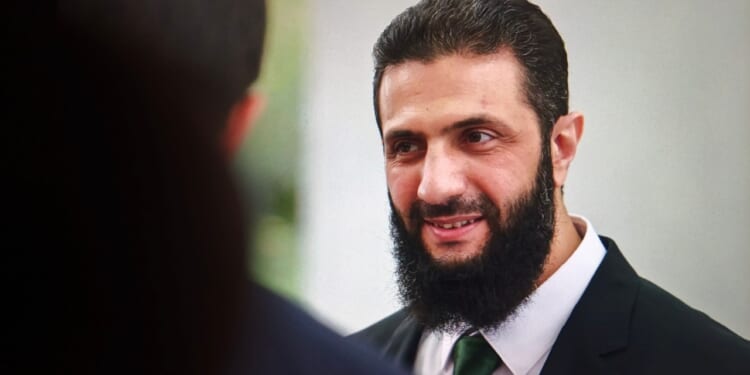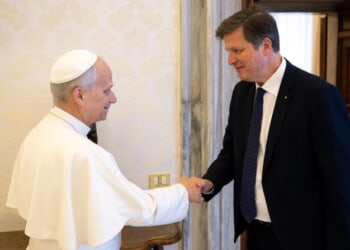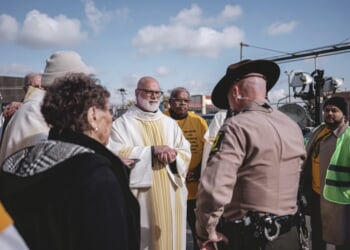From the cellblock to statesman, the story of Syrian president Ahmed Al-Shara’s transformation is a rare one in the Middle East.
Several weeks ago in New York City, I sat across from Ahmed al-Shara, a man our forces in Iraq detained in 2006 for his actions with Al Qaeda, and who is now the President of Syria. Ahmed al-Shara’s journey from a radicalized youth in Iraq to the helm of a fractured nation is not just improbable, it is unprecedented.
Before I interviewed al-Shara on stage at the Concordia Summit, I spent time revisiting his trajectory—a path that reminded me of some of the darkest chapters of the post-9/11 era and the most fragile hopes of the Arab Spring. Al-Shara was captured by US forces in Iraq in 2006 while he was planting explosives near Mosul. He had been a cell leader with Al Qaeda in Iraq, a group responsible for some of the most brutal attacks of that period. He spent five years in our detention facilities and was in detention in 2007 and 2008 when I returned to Iraq and commanded the Surge, during which our forces defeated Al Qaeda in Iraq.
While I never knew him or even heard his name at that time, I knew his type: ideologically committed, tactically dangerous, and a serious threat to our forces. Indeed, as I prepared to interview him, I thought about the families whose sons or daughters, husbands or wives were killed by him and his fellow jihadis and what they would think when the commander to whom they had once entrusted their loved ones sat across from a one-time leader of Al Qaeda in Iraq.
What followed al-Shara’s release in 2011 defied expectations. He returned to Syria and quickly emerged as a leader of the al-Nusra Front, an Al Qaeda affiliate and one of the elements that had risen against the murderous Bashar al-Assad regime. (Contrary to some accounts on social media, he was not one of our “assets” when I served as Director of the CIA in 2011 and 2012; moreover, contrary to my recommendations at the time, the United States government provided only very modest assistance to the forces fighting against Syria’s regime elements during that period).
By 2016, al-Shara had severed ties with Al Qaeda and rebranded his movement as Hayat Tahrir al-Sham (HTS). This eventually became the dominant element in Idlib Province in northwest Syria and a formidable military force. Under his leadership, HTS even built rudimentary governance structures—courts, trade systems, education facilities—albeit with authoritarian and Islamist overtones.
Then came the moment in late 2024 that changed Syria’s trajectory—al-Shara’s forces toppled the murderous regime of Bashar al-Assad. HTS elements had sought to liberate Aleppo in the north from regime forces, and when it fell more easily than had been expected, they continued south to free Hama and Homs from regime control. With Assad regime elements collapsing in front of them, the road to Damascus was open, and al-Shara’s forces pressed on, prompting Bashar al-Assad and his wife to flee to Russia.
By January 2025, al-Shara had been sworn in as President of Syria. After years of sanctioning the Bashar al-Assad regime and designating HTS a terrorist organization, the United States lifted many of the sanctions and the $10 million bounty on al-Shara (though Congressional sanctions remain—and should now be lifted, while also tying future assistance to actions on the ground by the new government). President Trump met with al-Shara in Riyadh in May during a gathering coordinated by Saudi Arabia’s leadership, and the president subsequently posted a favorable observation on al-Shara on Truth Social.
When I met al-Shara backstage at the Concordia Summit, on the margins of the UN General Assembly, I was struck by his demeanor: soft-spoken, thoughtful, measured. He possessed an impressive vision and considerable knowledge of the components of Syria’s economy and infrastructure. He spoke not as a revolutionary, but as a man burdened by history and determined to reshape it. On stage, he observed, “We cannot judge the past based on the rules of today and cannot judge today based on the rules of the past.”
It was a line that resonated—not just with the audience, but with me—even as I recalled that this was a man who had led Al Qaeda attacks against our forces in Iraq. The audience, which included many enthusiastic Syrian Americans who had long hoped for the overthrow of Bashar al-Assad, was clearly impressed and heartened by al-Shara’s words on stage. So was I. Indeed, we were all “fans” of what he stated he was trying to achieve.
Al-Shara now seeks to unify Syria, a country through which many of the ethnic, sectarian, and tribal faultlines of the Middle East run. He is trying to establish governance that is representative of all of Syria’s myriad entities and that ensures minority rights alongside majority rule. He is seeking to bring Syria’s many diverse elements under state authority and to rebuild Syria’s war-torn economy and devastated infrastructure. He has opened backchannel talks with Israel and called for the repeal of the Caesar Act sanctions that originated in Congress and were imposed on the previous regime. His rhetoric is nationalist, not jihadist. And his posture is pragmatic, not ideological.
Is this transformation genuine? Time will tell. There have already been actions and episodes that should give us pause, including executions linked to his forces of Druze in southern Syria and Alawites on the Mediterranean coast.
But as someone who has spent a lifetime studying insurgency, counterinsurgency, and post-conflict governance, I know that redemption in geopolitics is rare—and fragile. And it is now in the interests of the Syrian people, Syria’s neighbors, and the United States that al-Shara and Syria succeed.
Interviewing Ahmed al-Shara, someone who was very much on the other side in our early years in Iraq, was not just a moment of personal reflection (and more than a bit surreal). It was also a reminder that history is not linear and that the most unlikely figures can sometimes become the most consequential. Let us hope that this proves to be the case with Ahmed al-Shara. Whether his transformation endures or falters, the stakes for Syria—and for us—could not be higher.
About the Author: David Petraeus
General David Petraeus, US Army (Ret.), commanded the Surge in Iraq, US Central Command, and the International Security Assistance Force in Afghanistan; served as the Director of the CIA; and is co-author of Conflict: The Evolution of Warfare from 1945 to Gaza.
All statements of fact, opinion, or analysis expressed are those of the author and do not reflect the official positions or views of the US government. Nothing in the contents should be construed as asserting or implying US government authentication of information or endorsement of the author’s views.
Image: FotoField / Shutterstock.com.

















